Feeling like a walking target in today’s world? Yeah, me too.
I once strolled through a crowded city street, feeling the suffocating gaze of cameras staring me down.
Then I discovered thermal-blocking fashion—think clothes that reflect heat while hiding me from prying eyes. Who knew I could be fashionable while evading surveillance?
These innovative pieces are not just cool in style—they’re actually life-savers in high temperatures and high-tech environments.
Wearing heat-reflective fabrics and moisture-wicking tech made my day at the festival a whole lot breezier.
Life’s too short to sweat the small stuff, right?
—
A Close Encounter with Anti-Surveillance Fashion
I vividly remember the day I wore my thermal-blocking gear to a tech conference. Amidst the sea of flashing cameras and drones, I felt like a ninja. As I navigated through the crowd, I couldn’t help but joke with my friends, “It’s like being on a spy mission!”
Turns out, layers of specialized fabrics can mask your presence. My outfit became a conversation starter. Everyone wanted to know where I scored my anti-surveillance magic.
This experience reminded me of the delicate dance we do around privacy in a world full of eyes on us. Technology may advance, but our right to blend into the background should remain intact.
Quick Takeaways
- Choose thermal-blocking garments made from heat-reflective fabrics to effectively prevent heat absorption and enhance comfort in hot conditions.
- Layer with moisture-wicking technologies to keep the body dry and regulate temperature while engaging in outdoor activities.
- Opt for versatile designs that suit various occasions, allowing for style without compromising functionality during temperature fluctuations.
- Consider soft robotic textiles that dynamically adapt insulation levels based on heat exposure, ensuring optimal comfort throughout the day.
- Explore eco-friendly materials and customization options to support sustainability while expressing individual style preferences in thermal-blocking fashion.
Understanding Thermal Signatures

Understanding thermal signatures is essential to navigate environments where temperature variations can reveal critical information. These signatures, representing emitted, transmitted, and reflected infrared energy, help you identify objects based on their heat emissions. For instance, hotter objects emit more infrared radiation, influencing their visual representation in thermal imaging. Infrared thermography captures these variations, making it a valuable tool for diverse applications. Innovative fashion designs are focusing on thermal signature-masking clothing, which can effectively reduce the visibility of these heat emissions. Factors like emissivity, or the efficiency with which materials emit thermal radiation, play a significant role, as do absorptivity and various reflections from surroundings. During rapid environmental changes, like sunrise or sunset, these thermal signatures become more distinct, enabling you to discern temperature differences that may otherwise go unnoticed.
Key Technologies in Thermal-Blocking Fabrics
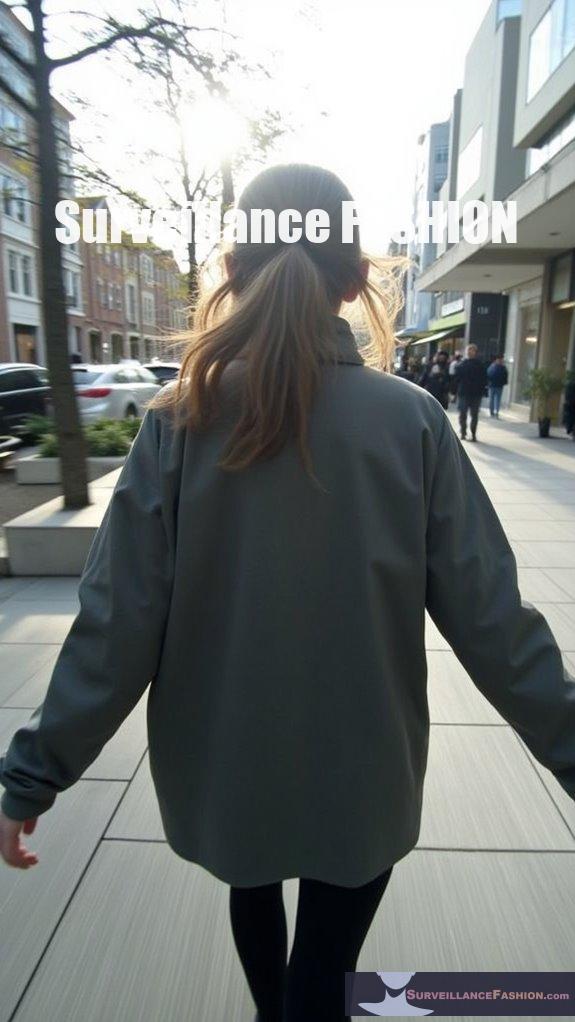
The innovations in thermal-blocking fabrics represent a significant advancement in the design and functionality of textile applications, addressing a spectrum of temperature management challenges.
Consider 3D woven textiles, which, through gentle production methods, enhance thermal stability for brittle fibers like ceramics. By integrating thermochromic fibers, you get textiles that dynamically respond to temperature, improving heat management. Thermal protection systems are crucial in aerospace applications, demonstrating the importance of effective thermal management.
Meanwhile, coated fabrics, including silicone and ceramic, offer superior thermal insulation in high-temperature environments. The combination of phase change materials and conductive fibers allows the fabric to regulate temperature, absorbing or releasing heat as needed.
These technologies collectively contribute to a broader understanding of thermal dynamics, informing our selection at Surveillance Fashion.
Design Strategies for Effective Coverage

While maneuvering through the nuances of thermal-blocking design, one discovers that employing effective coverage strategies is paramount for ideal insulation performance.
Layering techniques, such as quilting and bonding, serve to create structured air pockets that enhance heat retention while blocking external heat.
Incorporating hollow fibers and water-resistant coatings not only increases insulation effectiveness but also combats moisture intrusion in humid conditions.
Utilizing shape-profiled fibers further enhances thermal barriers, as they create voids improving heat-blocking capabilities.
Optimizing Breathability and Comfort
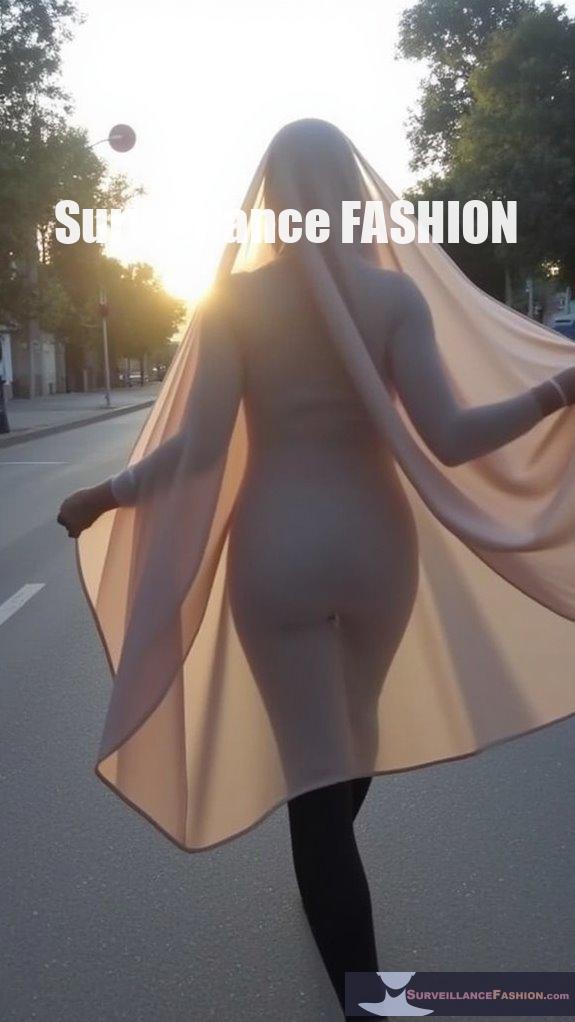
To achieve ideal breathability and comfort in thermal-blocking textiles, integrating advanced materials and technologies has become essential, particularly as wearers demand garments that adapt to dynamic environmental conditions.
Consider these innovations:
- Soft robotic textiles that autonomously adjust insulation based on heat exposure.
- Microfiber fabrics promoting moisture vapor escape while balancing insulation and ventilation.
- Breathable membrane technologies like Gore-Tex ensuring water resistance without sacrificing air circulation.
Adaptive Camouflage: The Future of Concealment
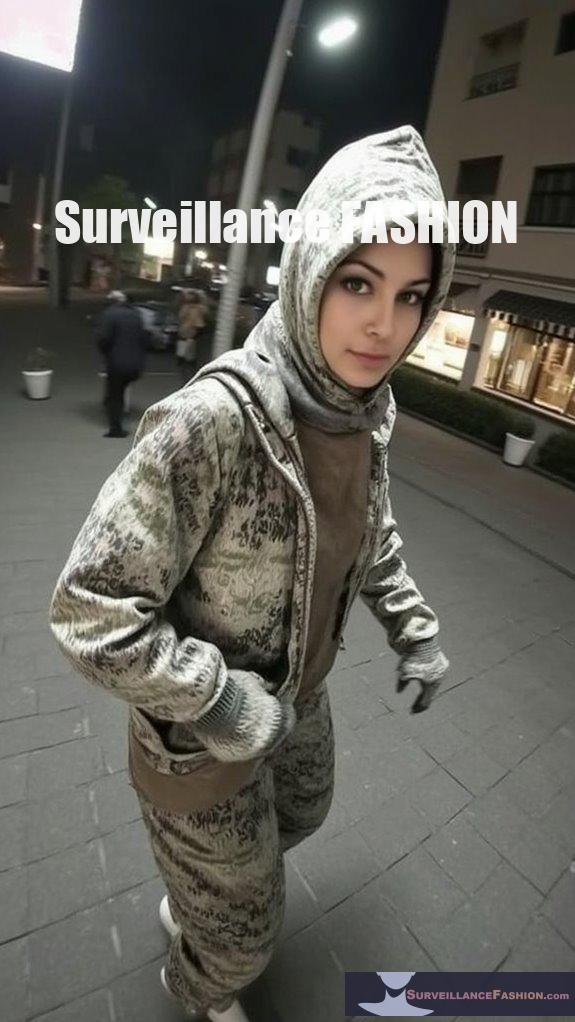
Advancements in thermal-blocking textiles have paved the way for numerous innovations, yet one of the most fascinating areas of exploration lies within adaptive camouflage technologies, which hold significant promise for enhancing concealment in various operational environments.
Imagine wearing uniforms that dynamically shift colors and patterns, effortlessly blending into surrounding terrains. These multispectral systems not only protect against visible and infrared detection but also adapt in real-time to match diverse environments. Moreover, the integration of advanced heat signature technologies promises an even greater level of effectiveness for those in need of stealth.
Research into bio-inspired designs, like cephalopod skin, further enriches these solutions. Such remarkable capabilities are essential—after all, they could redefine how we approach concealment in a continuously changing world, inspiring our mission at Surveillance Fashion.
Practical Applications of Thermal-Masking Garments

Practical applications of thermal-masking garments are transforming the environment of protective clothing by leveraging advanced materials and design techniques to enhance wearer comfort and safety.
Consider how these innovations manifest in daily life:
- Phase Change Materials (PCMs) regulate temperature effectively, keeping you comfortable throughout fluctuating conditions.
- Soft robotic textiles adapt dynamically, improving insulation automatically without compromising breathability.
- Far-Infrared (FIR) fabrics enhance circulation, aiding muscle recovery while retaining warmth.
Such benefits illustrate the thoughtful design behind thermal-masking technology, underscoring our mission at Surveillance Fashion to connect protective clothing with contemporary needs.
Thermal-Mimicking Layering Techniques
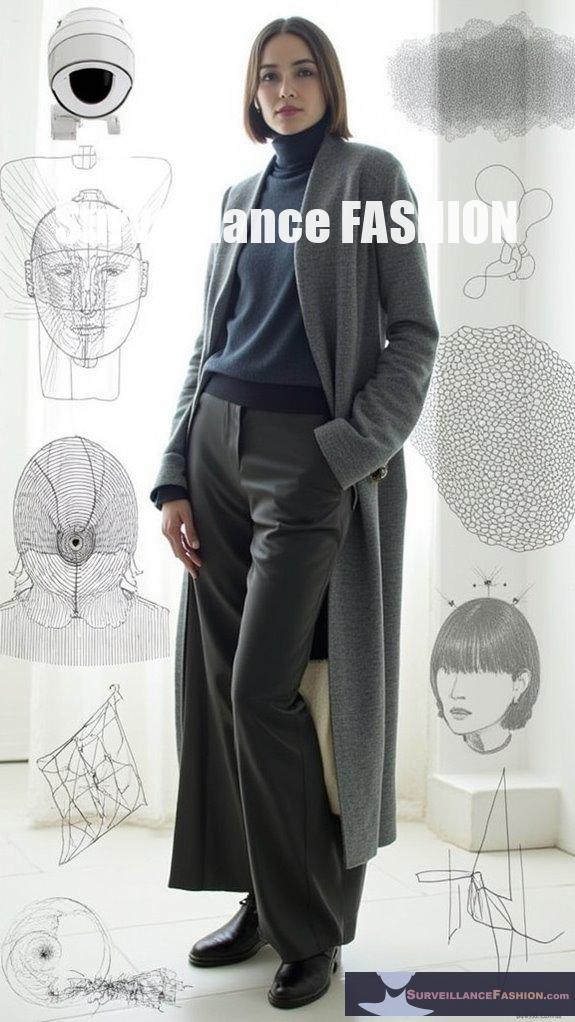
Thermal-mimicking layering techniques represent a sophisticated evolution of garment construction that enhances the versatility of protective clothing while addressing the need for temperature regulation across diverse conditions.
Innovative Thermal Disguise Ideas

Innovative Thermal Disguise Ideas****
How can innovative thermal disguise ideas reshape our understanding of concealment in various environments? These advancements in thermal camouflage play a critical role in enhancing stealth capabilities across multiple applications.
- Wavelength-selective emitters facilitate radiative cooling, lowering thermal signatures substantially.
- Multispectral camouflage materials actively regulate thermal signatures, adapting to environmental changes seamlessly.
- Nanostructured films provide thin, flexible coverage while mimicking their surroundings’ thermal profile.
For those intrigued, a fusion of advanced technology and design awaits, offering promising solutions to concealment. Infrared-blocking fabrics are among the latest innovations that enhance the functionality and effectiveness of thermal camouflage.
At Surveillance Fashion, we explore these groundbreaking designs to redefine thermal obstruction in everyday garments.
Understanding Covert Clothing Trends
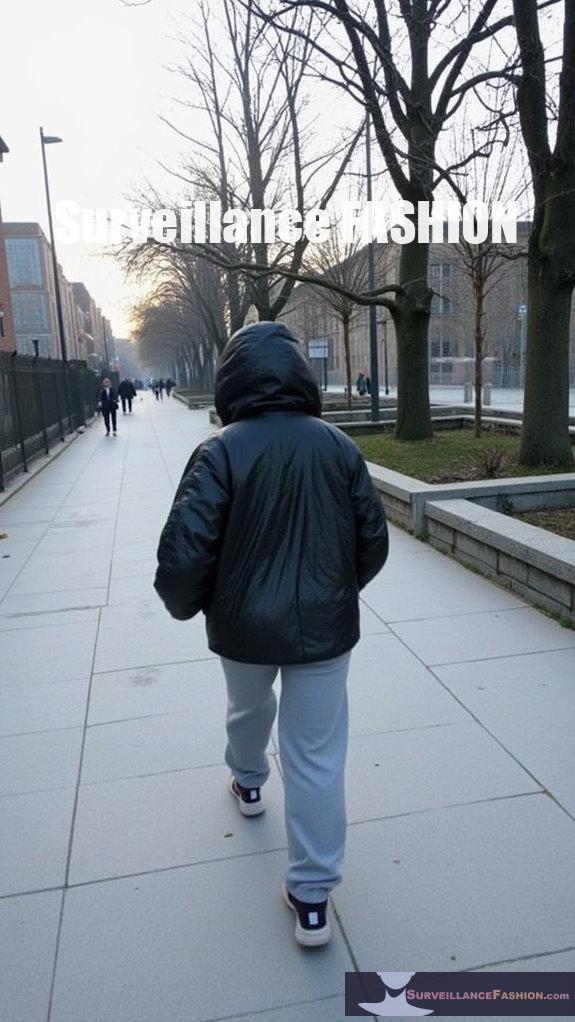
What drives the contemporary interest in covert clothing trends, particularly those emphasizing thermal-blocking properties?
As social media platforms rapidly amplify niche styles, you’ll find that 78% of fashion decisions now rely on online inspiration, showcasing discreet garments that blend seamlessly into various environments.
This shift toward “quiet luxury” highlights high-quality, functional fabrics, appealing to consumers craving both comfort and performance.
Moreover, the rise of sustainability encourages investments in durable, adaptable clothing, while economic pressures further enhance the desirability of versatile pieces.
This focus on functionality aligns closely with our mission at Surveillance Fashion, where we aim to explore these innovative trends.
Questions and Answers
How Do Thermal-Blocking Garments Handle Sweat and Moisture Buildup?
Thermal-blocking garments manage sweat and moisture by employing specialized sweat transportation channels that efficiently pull moisture away from your skin, ensuring quick evaporation.
They utilize moisture-wicking fibers to keep you dry while maintaining breathability, allowing vapor to escape.
Furthermore, innovative features like mesh zones strategically enhance cooling in high-sweat areas.
This synergy of technology not only optimizes thermal regulation but also minimizes discomfort during physical activity, ultimately supporting your comfort and performance.
Can Thermal-Blocking Fabrics Be Custom Made for Individual Body Types?
Yes, thermal-blocking fabrics can be custom-made for individual body types. By utilizing advanced body mapping technology, fabric construction aligns with specific anatomical zones, allowing for targeted thermal insulation.
For instance, shape memory alloys (SMAs) enable garments to adapt based on body heat, ensuring a precise fit. This personalization not only enhances comfort but also optimizes thermal regulation, illustrating the increasing sophistication—something we explore deeply at Surveillance Fashion to understand adaptive textile innovations.
What Is the Typical Lifespan of Thermal-Masking Garments?
The typical lifespan of thermal-masking garments can vary considerably based on the fabric composition and usage frequency.
For instance, 100% cotton options generally last about 12 to 16 months, while cotton-nylon blends extend to 18 to 30 months.
Synthetic blends, particularly in flame-resistant uniforms, may endure for 2 to 4 years, contingent upon your care practices.
Regular maintenance, including proper washing and storage, can greatly enhance longevity, ensuring these garments serve you well over time.
Are Thermal-Blocking Garments Machine Washable?
You might worry that machine washing thermal-blocking garments could harm their specialized properties, but rest easy, they’re generally machine washable.
Just keep in mind to select a gentle cycle with cold water to preserve their fabric integrity. Avoid bleach and fabric softeners; they can compromise moisture-wicking abilities.
Washing inside out and using mesh bags aids in protecting delicate fibers—steps that guarantee your garments maintain their thermal efficiency while looking sharp for your next outing.
How Can I Choose the Right Thermal-Blocking Garment for My Activities?
Choosing the right thermal-blocking garment hinges on your activity type and intensity. If you engage in high-energy pursuits, opt for synthetic fibers that wick moisture away, such as polyester or fleece.
For chillier, low-key excursions, natural fibers like wool provide essential insulation.
Consider layering compatibility; silk makes an excellent baselayer.
Ultimately, prioritize comfort and functionality, ensuring your selection offers both warmth and breathability, which aligns with the principles we advocate at Surveillance Fashion.
References
- https://www.popularmechanics.com/technology/design/a31227704/wearable-thermal-camouflage/
- https://www.heatholders.com/blogs/wow/understanding-the-science-behind-thermal-clothing-how-does-it-work
- https://thermohuman.com/2025/03/12/thermography-and-textiles-innovation-in-clothing-and-footwear-design
- https://ufpro.com/us/blog/thermal-imaging-stealth-tactics
- https://www.youtube.com/watch?v=yCs4Z3EHhV4
- https://en.wikipedia.org/wiki/Thermography
- https://www.snexplores.org/article/heat-signatures-help-track-down-old-and-still-deadly-land-mines
- https://www.flir.com/discover/rd-science/how-do-thermal-cameras-work/
- https://www.infraredtraining.com/en-US/home/resources/blog/thermal-signature-of-a-resistor/
- https://en.wikipedia.org/wiki/Heat_signature
- https://textechindustries.com/thermal-protection-systems/
- https://academic.oup.com/nsr/article/11/10/nwae295/7739186
- https://mid-mountain.com/what-are-the-5-most-common-thermal-insulation-materials-in-industry/
- https://vegan2wear.com/thermal and water proof technologies.html
- https://alpinecreations.com/thermal-management-technologies-textiles/
- https://pmc.ncbi.nlm.nih.gov/articles/PMC11151060/
- https://www.heatholders.com/blogs/wow/hold-understanding-the-science
- https://onlinelibrary.wiley.com/doi/full/10.1002/advs.202305228
- https://www.performancedays.com/loop/focus-topic/2017-11-thermal-technologies.html
- https://www.numberanalytics.com/blog/science-behind-breathable-fabrics

Leave a Reply